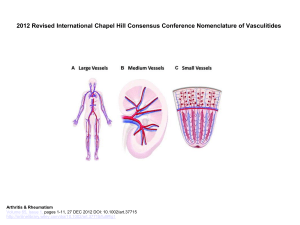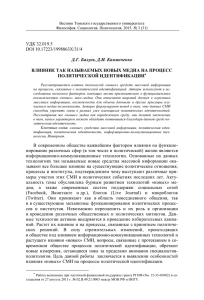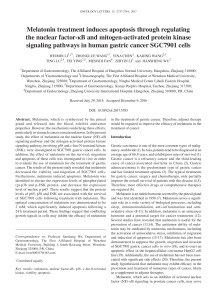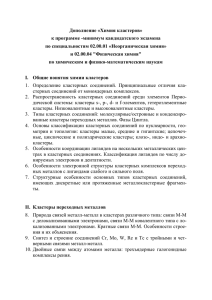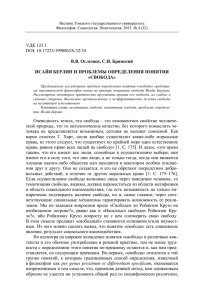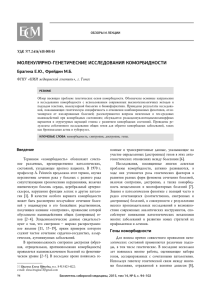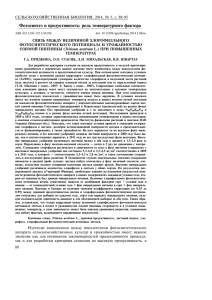
Preprints (www.preprints.org) | NOT PEER-REVIEWED | Posted: 8 April 2020 doi:10.20944/preprints202004.0122.v1 Can melatonin reduce the severity of COVID-19 pandemic? Alexander Shneider1,2,#, Aleksandr Kudriavtsev 3,4, Vakhrusheva Anna Vladimirovna3 1. CureLab Oncology, Inc., Dedham, MA 2. Ariel University, Dept. of Molecular Biology, Ariel, Israel 3. Lomonosov Moscow State University, Biological Faculty, Moscow, Russia 4. Emanuel Institute of Biochemical Phisics, RAS, Moscow, Russia # To whom correspondence should be addressed: ashneider@curelab.com, Tel. +1-609841-1201 Abstract The current COVID-19 pandemic is one of the most devastating events in recent history. The virus causes relatively minor damage to young, healthy populations, imposing lifethreatening danger to the elderly and people with diseases of chronic inflammation. So, if we could reduce the risk for vulnerable populations, it would make the COVID-19 pandemic more similar to other typical outbreaks. Children do not suffer from COVID-19 as much as their grandparents and have a much higher melatonin level. Bats also do not suffer from the virus they transmit, and bats too have a much higher level of melatonin. Viruses generate an explosion of reactive oxygen species, and melatonin is the best natural antioxidant that is lost with age. Melatonin inhibits the programmed cell death which coronaviruses induce, causing significant lung damage. Coronavirus causes inflammation in the lungs which requires inflammasome activity. Melatonin blocks the inflammasome. The immune response is impaired by anxiety and sleep deprivation. Melatonin improves sleep habits, reduces anxiety and stimulates immunity. Fibrosis may be the most dangerous complication after COVID-19. Melatonin is known to prevent fibrosis. Mechanical ventilation may be necessary but yet imposes risks due to oxidative stress, which can be reduced by melatonin. Thus, by using the safe over-the-counter drug melatonin, we may be immediately able to prevent the development of severe disease symptoms in coronavirus patients, reduce the severity of their symptoms, and/or reduce the negative effects of coronavirus infection on patients’ health after the active phase of the infection is over. Keywords: Melatonin, coronavirus, pandemic, SARS-CoV-2, bat, lung, p62, apoptosis, programmed cell death, mortality, morbidity, prevention, vaccine, adjuvant, drug, symptoms. 1. Elderly have reduced level of melatonin © 2020 by the author(s). Distributed under a Creative Commons CC BY license. Preprints (www.preprints.org) | NOT PEER-REVIEWED | Posted: 8 April 2020 doi:10.20944/preprints202004.0122.v1 The effect of SARS-CoV-2 on humans is clearly age-related. So far, very few deaths from COVID-19 have been recorded in people under the age of 20, while the elderly have an excessively high mortality rate. We hypothesize that, at least partially, the increased sensitivity to coronavirus in the elderly is due to their reduced level of melatonin. The study [1] measured the concentration of melatonin in 81 healthy people (44 men and 37 women) aged 1 to 92 years. The authors observed a significant negative correlation between the daily concentration of melatonin in the blood and age. At the same time, there was no difference between men and women. Daily variations in melatonin in young people (age 26 +/-2 years) were in the region of 7 pg/ml, and in people aged 84 +/-2 years, the level of melatonin dropped to 2 pg/ml. A significant difference was also observed in the production of melatonin at night. A night peak of melatonin for young people was observed at the level of 83 +/-20 pg/ml, while for the elderly - only 11.2 +/-1.6 pg/ml. The concentration of melatonin in the blood was assessed for 367 people (210 men and 157 women) during both morning (from 7:30 to 10 am) and evening (from 11 pm to 1 am) hours. The age range was from 3 to 90 years old [2]. The highest concentration of melatonin (329.5 +/42 pg/ml) was in 1-3 year old children. After this age, there was a sharp decline in the average melatonin level by almost 80%. Then a negative correlation between age and melatonin concentration remained over the period of 20-90 years. Here are the average melatonin values for the age groups: 1-3 years old – 260 pg/ml, 5-7 y.o. – 160 pg/ml, 7-11y.o. – 100-110 pg/ml, 1115 y.o. -80-85 pg/ml, 15-50 y.o. 50-55 pg/ml, 50-70 y.o. 27.8 pg/ml, 70-90 y.o. – 15.3 pg/ml. The age-related changes in melatonin levels were observed during the nightly production of melatonin only. For daytime melatonin, no difference was found. Such an age-dependent biphasic drop in melatonin (a sharp decline followed by a more moderate drop) is characteristic not only of humans but was detected in rats and some other mammals as well [2]. An agedependent decline in night-time melatonin levels was also reported for both genders in a review which summarizes data of 18 studies analyzing melatonin levels in blood as a function of age [3]. Thus, the application of melatonin may partially alleviate age-related comorbidities exacerbating SARS-CoV-2 infection and increasing its risk [4,5]. 2. Bats have higher levels of melatonin than humans The dominant hypothesis today is that SARS-CoV-2 virus is a zoonosis that took place many times in human history [6]. Natural carriers of these viruses are bats of the genus Rhinolophus. SARS-CoV-2 is 96% identical to another bat’s coronavirus Bat-SARSr-CoV RaTG13 [7]. If one excludes the option of a laboratory spill, considering only the option of natural transmission from bats to humans, it would be logical to assume that the virus is relatively harmless for its natural host during longtime coexisting [8,9,10]. Melatonin production is controlled by photosensitive retinal-containing receptors via norepinephrine and adrenergic receptors [11]. Melatonin is produced in response to darkness and its synthesis is inhibited by light [12]. Rhinolophus bats are nocturnal hunters. During the day, Preprints (www.preprints.org) | NOT PEER-REVIEWED | Posted: 8 April 2020 doi:10.20944/preprints202004.0122.v1 they hide in dark places, such as caves or bat mines, staying awake at night. Thus, they are less exposed to daylight which would reduce their melatonin level. Indeed, a number of studies indicate that the concentration of melatonin in bats at night varies from 60 to 500 pg/ml and that the daytime concentration also remains at a high level of 20-90 pg/ml depending on the species [13,14]. As described above, melatonin levels are lower in humans, especially in elderly populations. Thus, among other factors, could bats be protected from the severe effects of coronavirus by possessing a high level of melatonin? 3. Melatonin reduces infection-associated oxidative stress Viral respiratory infections are associated with oxidative stress characterized by elevated levels of reactive oxygen (ROS) and/or nitrogen species (RNS) [15]. Oxidative stress sensitive genes were upregulated in the peripheral blood mononuclear cells of SARS-CoV-1 human patients [16]. Viral infections causing severe lung injury and oxidative stress in the lung may form a positive feedback loop. For example, SARS-CoV induces oxidative stress; oxidative stress induces the expression of PLA2G2D phospholipase; higher expression of PLA2G2D reduces antiviral immunity, making the virus more lethal. Notably, the expression of PLA2G2D is naturally increased with age [17]. Depriving bats of their antioxidant protection increases the lethality of coronavirus. At the same time, experimental animals with deleted components of ROSgenerating machinery may be more resistant to respiratory viruses [18]. Melatonin possesses high antioxidant properties. It binds up to 10 free radicals per molecule, while such classic antioxidants as vitamins C and E bind just one [19]. Also, melatonin has a high bioavailability, penetrating blood-brain barrier and placenta [20]. Indirectly, the antioxidant properties of melatonin are linked to an increased activity of superoxide dismutase, glutathione peroxidase, reductase and catalase [21,22,23,24]. 4. Coronavirus activates inflammasome and causes inflammation, which melatonin reduces Researchers believe that SARS-CoV-2 causes severe lung pathology by inducing pyroptosis [25], a highly inflammatory form of programmed cell death [26]. Pyroptosis in macrophages and other immune cells of the immune system can lead to symptoms such as lymphopenia [27] that blocks an effective immune response to the virus. As the molecular biology of SARS-CoV-2 is yet to be studied, we have to use data on the inflammatory mechanisms of SARS-CoV-1. A viral protein encoded by ORF8b directly interacts with inflammasome NLRP3 (nucleotide-binding domain leucine-rich repeat (NLR) and pyrin domain containing receptor 3) [28], which activates the adaptor protein ASC and caspases 4,5 and 11. This leads to a disruption of the cell membrane and the inflammatory release of cell content to the extracellular space [29]. Simultaneously, it induces pro-inflammatory cytokines (e.g. IL-1β и IL-18) [30]. Thus, it is necessary to inhibit pyroptosis by acting on NLRP3, preferably immediately in the lungs. The mechanisms of NLRP3 inhibition have been studied [31], and melatonin reported as NLRP3 inflammasome inhibitor [32]. On the model of bacterial pneumonia, LPS-induced ALI mouse model, it was shown that melatonin successfully inhibits pneumonia through interfering with NLRP3 inflammasome, protecting macrophages from pyroptosis [33]. Other publications also demonstrate that Preprints (www.preprints.org) | NOT PEER-REVIEWED | Posted: 8 April 2020 doi:10.20944/preprints202004.0122.v1 melatonin may be an effective inhibitor of pyroptosis and pathologies associated with it [34,35,36,37,38,39]. 5. Melatonin can reduce immunosuppression induced by chronic stress and sleep deprivation The COVID-19 societal crisis has led to massive and prolonged stress, anxiety and sleep deprivation, which shall become a subject of systemic scientific analysis. These obvious factors may have a severe negative effect on the immune system and peoples’ ability to resist COVID-19 as well as other infections. Stress and sleep deprivation may have a dual effect on the immune system. Short-term stress has an immunomodulating effect. In contrast, prolonged stress suppresses immunity. Chronic stress reduces the number and activity of protective immune cells while stimulating immunosuppressive mechanisms (for example, increasing the number and/or activity of regulatory T-cells) and producing a pro-inflammatory response [40]. Similar effects on immunity are observed with short-term and chronic sleep deprivation. It is the latter that has a more negative effect on immunity, while short sleep insufficiency can even have a hormesis effect [41]. The immune system, like the neuroendocrine one, has its own rhythms. For example, the overnight release of melatonin is synchronized with the peak of the proliferation of progenitor cells for their subsequent differentiation into granulocytes and macrophages [42,43,44]. The phagocyte activity increases concomitantly with the nocturnal peak of melatonin based on circadian rhythms [45]. There is also a decrease in the number and activity of natural killer cells at night, along with anti-inflammatory cytokines (e.g. IL-10), with a simultaneous increase in the number of naive T-cells and pro-inflammatory cytokines such as IL-2, IL-6, IL-12, TNF-alpha [46]. The increase in the pro-inflammatory effect is limited in duration (only during the night) and is compensated by the strong anti-inflammatory response that prevails during the day. In the case of sleep deprivation, an even greater increase in the pro-inflammatory level was shown: doubled mRNA level of cytokine IL-1β [47], increased levels of IL-6 and TNF-alpha receptors [48], and reduced levels of anti-inflammatory IL-10 [41,46]. Not surprisingly, sleep deprivation leads to multiple diseases associated with chronic inflammation such as cognitive, cardiovascular, metabolic and other disorders [49,50]. Other effects of sleep deprivation included decreased lymphocyte proliferation after 48 hours without sleep [51]; reduced phagocyte activity after 72 hours of sleep deprivation [52]. Healthy volunteers sleeping less than 6 hours for a week had reduced levels of neutrophil phagocytosis, lower levels of NADPH oxidase, and fewer CD4+ T cells, which are necessary for anti-infective defense and proper vaccination response. The level of NADPH oxidase remained reduced even after a week of the restored amount of sleep, which indicated long-lasting effects of sleep deprivation [53]. Moreover, sleep deprived people immunized against the influenza A virus revealed a much lower level of antibodies than those immunized without sleep deprivation [54]. Also, immunization against the hepatitis A virus showed lower antibody titers in people with a lack of sleep after one night [55]. Suppression of the immune system resulting in pathogenic Preprints (www.preprints.org) | NOT PEER-REVIEWED | Posted: 8 April 2020 doi:10.20944/preprints202004.0122.v1 microorganisms in blood and sepsis was recorded in sleep-deprived rats [56]. Long-term sleep deprivation leads to oxidative stress, reducing the activity of antioxidant enzymes [57,58]. Consequently, long-term sleep deprivation and/or chronic stress leads to the deterioration of immune functions through the disturbance of barrier mechanisms by suppressing the phagocytosis, reducing proliferation and activity of some leukocytes, in particular CD4 + T cells, while increasing T-suppressors as well as elevating oxidative stress and pro-inflammatory background. Thus, people with chronic sleep deprivation and/or stress are particularly susceptible to infectious diseases. The production of melatonin is significantly impaired in people with chronic insomnia. The longer a person has experienced symptoms of insomnia, the greater the effect on melatonin concentration: if more than five years, then peak value 72.1 ± 25.0 pg/ml (age 41.8 ± 11.7 years; duration 15.3 ± 5.9 years;), if less, then the peak value is 98.2 ± 23.9 pg/ml (age 40.6 ± 6.5 years; duration 3.8 ± 1.5 years) [59]. However, in the case of chronic stress, initially, the concentration of melatonin rises significantly as a protective mechanism exerting anti-inflammatory and antioxidant effects, dropping sharply after [60]. Thus, restoring (even partially) normal sleep habits and reducing anxiety through melatonin may have a significant public health effect during current COVID-19 crisis. 6. Melatonin can be utilized in combinations with drugs and treatments Currently, the following drugs are most often used to treat coronavirus infection: the combination of the antiviral drugs lopinavir / ritonavir [61], nucleotide analogues that inhibit RNA-dependent-RNA polymerize of the virus – ribavirin [62] and remdesivir [63], anti-malarial drug hydroxychloroquine (less toxic analog of chloroquine) [64], sometimes in combination with the antibiotic azithromycin [65], and the glucocorticoid methylprednisolone [66]. According to a recent study on lopinavir / ritonavir, the combination of drugs used to treat AIDS did not show any benefits compared to standard hospitalization [67]. One of the reasons may be the doselimiting toxicity of these drugs. Nevertheless, it is shown in animal studies that melatonin and alpha lipoic acid can reduce damage to the kidneys from oxidative stress caused by the lopinavir / ritonavir combination [68]. Therefore, if melatonin is used as an adjuvant to this combination, the side effects of the drug combination can be reduced, and the dose increased. Ribavirin, remdesivir and other nucleotide analogues targeting RNA-dependent RNA polymerase are a popular strategy. Indeed, neither humans nor animals have this enzyme, thus, in principle, substances of this group can be highly selective. Combining nucleotide analogues with melatonin may provide additional benefits. For example, melatonin increased ribavirin potency as an anti-influenza agent, probably due to the immunomodulatory functions of melatonin [69]. In vitro studies have shown that ribavirin in combination with melatonin shows improved properties for inhibiting replication and respiratory syncytial virus [70]. Chloroquine and hydroxychloroquine are viewed today as the most promising antiCOVID-19 drugs. One could apprehend that melatonin would interfere with them because it was reported that the anti-malaria effectiveness of chloroquine was greatly increased by a melatonin antagonist, Luzindole, and/or bright light at night, which reduced melatonin production. However, these worries are unwarranted because the anti-malaria effect of melatonin Preprints (www.preprints.org) | NOT PEER-REVIEWED | Posted: 8 April 2020 doi:10.20944/preprints202004.0122.v1 suppression is based on the direct benefits malarial plasmodium gains from direct interaction of melatonin with its melatonin receptors. This interaction leads to the activation of malaria Ca 2+ signaling pathway and eventually to increased parasitemia. None of these molecular events, and pathologies associated with them, can take place during coronaviral infection due to the completely different nature of the infective agent. At the same time, even the research on the anti-malaria effect of melatonin antagonists noticed that high doses of melatonin are beneficial for malaria treatment because they inhibit programmed cell death and oxidative stress [71]. Thus, applying melatonin as an adjuvant to chloroquine and hydroxychloroquine treatments of COVID19 may reduce the necessary doses, and thus toxicity, of these agents [72]. Methylprednisolone is used to relieve edema, which is justified in the case of SARS, where, as previously indicated, edema contributes significantly to lung dysfunction, leading to their failure. The activity of melatonin as a protective drug compared to methylprednisolone was studied in mice with spinal cord injuries [73]. It was shown that the protective properties in comparison with methylprednisolone in melatonin were higher. The combination of these drugs has led to even greater efficacy for relieving edema [74], so melatonin can be used in combination with prednisone to relieve edema with greater efficacy in patients suffering from pneumonia with SARS-CoV-2. From all of the above, the need for clinical trials to verify the effectiveness of melatonin as an adjuvant used in combination with other drugs is evident. 7. Melatonin as a vaccine adjuvant and antiviral immune stimulant Vaccines made our entire modern civilization possible together with soup and antibiotics eradicating horrifying infections. Currently, multiple efforts to generate safe and effective vaccines against coronaviruses, specifically anti-COVID-19, are underway. For example, the experimental vaccine mRNA-1273 (Moderna, Inc.), which is in the first stage of clinical studies [75]. This virus may be a good target for vaccine development because, unlike the influenza virus, it has a low mutation rate, which would make it unlikely for it to escape the immune response. However, even when/if such a vaccine would be developed, it may not be as effective for the elderly and other sensitive population groups as it would be for young healthy adults. Limited immune response to vaccines was reported for these groups before due to immunosenescence [76,77]. Thus, adjuvants enhancing vaccine efficacy in the elderly are urgently needed amidst the COVID-19 crisis and melatonin may be one of them [78]. Natural killer and CD4+ cells, as well as cytokine production necessary for effective vaccine response, are enhanced by melatonin partially reverting age-related immune decline. For younger populations, supplementing preventive vaccination with preventive and/or therapeutic melatonin use may constitute a feasible strategy as well due to its immunomodulating properties [79]. Use of melatonin as an antiviral immunostimulant may be further supported by the following animal data. It prevented the development of paralysis and death in mice infected with sublethal doses of the encephalomyocarditis virus [80] as well as reducing the mortality in mice infected with encephalitis viruses [81]. Also, it improved some immune parameters after traumahemorrhage [82]. It is worth noting that lack of sleep reduces the body's ability to respond to viral infections. The shorter the sleep, the higher the frequency of colds [83], and one of the most Preprints (www.preprints.org) | NOT PEER-REVIEWED | Posted: 8 April 2020 doi:10.20944/preprints202004.0122.v1 important factors in this may be melatonin [84]. Thus, melatonin intake can increase the protective functions of the body against infections. 8. Can melatonin prevent the main danger, post-COVID-19 lung fibrosis? One of the most important complications of COVID-19 can be pulmonary fibrosis, which may manifest itself as a progressive disease with a terminal stage characterized by severe pulmonary hypertension and pulmonary heart disease. Although it is not yet possible to predict what the actual mortality due to respiratory failure and the 5-years survival will be for COVID-19, this was a common danger for most patients during the previous SARS-CoV-1 epidemic [85]. Pulmonary fibrosis can be a side effect of mechanical ventilation [86] due to the mechanical stress leading to an epithelial-mesenchymal transition [87]. Oxidative stress is an additional risk factor for the development of fibrosis [88]. Animal studies have shown that the inhibition of oxidative stress can protect against the development of fibrosis [89]. The role of melatonin antioxidant properties in the prevention of COVID-19 postinfection complications should be addressed with no delay. Melatonin's ability to protect patients from pulmonary fibrosis through the Hippo / YAP pathway has already been shown [90]. Considering that millions of people can be infected with COVID-19, while only several tens of thousands were with SARS-CoV-1, applying melatonin to prevent pulmonary fibrosis may be even more important than mitigating the acute SARS-CoV-2 infection per se. 9. Can melatonin reduce the risk of mechanical ventilation? Although elderly people possess a higher mortality rate, a high number of young COVID19 patients receive mechanical ventilation due to low blood oxygen saturation and difficulty breathing [91]. Mortality was increased in patients even with moderate hyperoxemia (with Pa (O2)> 100 mm Hg), staying for 1 to 7 days on artificial respiration apparatuses, as shown by the multicenter cohort observational study [92]. Ventilation was reported to enhance pulmonary inflammation in acute lung damage [93] and increased oxidative stress in the alveoli [94]. As presented above, melatonin may be quite effective against oxidative stress. Thus, melatonin may resolve a contradiction between the urgent clinical necessity to give a patient mechanical ventilation and the threat this ventilation may possess. 10. Economic feasibility Modern medicine often operates in a price-ignorant manner, placing the burden on the economies of developed countries and widening the gap between rich and poor nations. Melatonin is an inexpensive product with scalable production. It has a long shelf life, the simplest mode of transportation, and can be self-administered orally in remote areas. No severe side effects are expected in the case of occasional overdoses. Thus, using melatonin to mitigate a world-wide pandemic outbreak may be a feasible and socially responsible public health measure. Also, some hospital systems and glass manufacturers may consider implementing simple and inexpensive light filters, reducing the amount of melatonin-reducing blue light in favor of red light less effecting melatonin [95]. Preprints (www.preprints.org) | NOT PEER-REVIEWED | Posted: 8 April 2020 doi:10.20944/preprints202004.0122.v1 11. What the next steps must be? The history of biomedical science, public health, and medical practice knows many examples of mental inertia and the price it cost in lives [96]. Under normal circumstances, the conclusion of this review would be to initiate prospective clinical studies dividing patients into case-control groups with one group receiving standards of care alone, and another – the standards of care supplemented with melatonin. However, under the current COVID-19 crisis, we see a severe ethical problem with this otherwise correct approach. Let’s assume that we conduct exactly this type of study and then conclude that melatonin reduces rates of hospitalization, demand in inhalation equipment and trained personal, morality and incidence in irreversible post-infection complications. Considering the fact that melatonin is known as a safe, inexpensive, readily-available OTC product, how would we justify to millions of people, who did not benefit from it at the time of a deadly crisis, that they and their relatives (who may not be alive anymore) were not timely informed of the potential benefits of melatonin? Thus, we believe that one should immediately conduct comprehensive retrospective studies comparing disease progression among patients who were or were not self-administering melatonin during the course of their disease. Although such data is not readily available yet, it is still possible to collect. The retrospective studies should be supplemented with a prospective one following the incidences and severity of post-infection complications in patients receiving and not-receiving melatonin. However, in addition to these above-mentioned conventional research strategies, we propose to immediately inform doctors, nurses, healthcare providers, and the general public of the potential benefits of melatonin. Extraordinary situations require out-of-the-box modus operandi. The lack of timely action is, in and of itself, an action. Acknowledgments The authors would like to thank Dr. Yuri Gankin and Dr. Andrey Komissarov for their intellectually stimulating discussions and Aaron Shneider for his comprehensive editorial work and medical communications effort. Conflict of interest The authors claim no conflict of interest. In contrast, the immediate successful application of melatonin to resolve current COVID-19 crisis may contradict their direct financial interest. ORCID Vakhrusheva Anna http://orcid.org/0000-0001-7948-1254 Kudriavtsev Aleksandr https://orcid.org/0000-0002-3918-5618 Shneider Alexander https://orcid.org/0000-0002-2150-6727 References Preprints (www.preprints.org) | NOT PEER-REVIEWED | Posted: 8 April 2020 doi:10.20944/preprints202004.0122.v1 1. Iguchi H, Kato K-I, Ibayashi H. Age-dependent reduction in serum melatonin concentrations in healthy human subjects. The Journal of Clinical Endocrinology & Metabolism. 1982;55:27–29. doi:10.1210/jcem-55-1-27. 2. Waldhauser F, Weiszenbacher G, Tatzer E, et al. Alterations in nocturnal serum melatonin levels in humans with growth and aging. The Journal of Clinical Endocrinology & Metabolism. 1988;66:648–652. doi:10.1210/jcem-66-3-648. 3. Scholtens RM, Munster BCV, Kempen MFV, et al. Physiological melatonin levels in healthy older people: A systematic review. Journal of Psychosomatic Research. 2016;86:20–27. doi:10.1016/j.jpsychores.2016.05.005. 4. Scheer FA, Montfrans GAV, Someren EJV, et al. Daily nighttime melatonin reduces blood pressure in male patients with essential hypertension. Hypertension. 2004;43:192–197. doi:10.1161/01.hyp.0000113293.15186.3b. 5. Zisapel N. New perspectives on the role of melatonin in human sleep, circadian rhythms and their regulation. British Journal of Pharmacology. 2018;175:3190–3199. doi:10.1111/bph.14116. 6. Parrish CR, Holmes EC, Morens DM, et al. Cross-species virus transmission and the emergence of new epidemic diseases. Microbiology and Molecular Biology Reviews. 2008;72:457–470. doi:10.1128/mmbr.00004-08. 7. Zhou P, Yang X-L, Wang X-G, et al. A pneumonia outbreak associated with a new coronavirus of probable bat origin. Nature. 2020;579:270–273. doi:10.1038/s41586-0202012-7. 8. Rodhain F. Chauves-souris et virus : des relations complexes. Bulletin De La Société De Pathologie Exotique. 2015;108:272–289. doi:10.1007/s13149-015-0448-z. 9. Hu B, Zeng L-P, Yang X-L, et al. Discovery of a rich gene pool of bat SARS-related coronaviruses provides new insights into the origin of SARS coronavirus. PLOS Pathogens. 2017;13. doi:10.1371/journal.ppat.1006698. 10. Fan Y, Zhao K, Shi Z-L, et al. Bat coronaviruses in China. Viruses. 2019;11:210. doi:10.3390/v11030210. 11. Pangerl B, Pangerl A, Reiter RJ. Circadian variations of adrenergic receptors in the mammalian pineal gland: A review. Journal of Neural Transmission. 1990;81:17–29. doi:10.1007/bf01245442. 12. Max M, Menaker M. Regulation of melatonin production by light, darkness, and temperature in the trout pineal. Journal of Comparative Physiology A. 1992;170. doi:10.1007/bf00191463. Preprints (www.preprints.org) | NOT PEER-REVIEWED | Posted: 8 April 2020 13. doi:10.20944/preprints202004.0122.v1 Heideman RD, Bhatnagar KR, Hilton F, et al. Melatonin rhythms and pineal structure in a tropical bat, Anoura geoffroyi, that does not use photoperiod to regulate seasonal reproduction. Journal of Pineal Research. 1996;20:90–97. doi:10.1111/j.1600079x.1996.tb00245.x. 14. Haldar C, Yadav R, Alipreeta. Annual reproductive synchronization in ovary and pineal gland function of female short-nosed fruit bat, Cynopterus sphinx. Comparative Biochemistry and Physiology Part A: Molecular & Integrative Physiology. 2006;144:395– 400. doi:10.1016/j.cbpa.2006.02.041. 15. Khomich O, Kochetkov S, Bartosch B, et al. Redox biology of respiratory viral infections. Viruses. 2018;10:392. doi:10.3390/v10080392. 16. Shao H, Lan D, Duan Z, et al. Upregulation of mitochondrial gene expression in PBMC from convalescent SARS Patients. Journal of Clinical Immunology. 2006;26:546–554. doi:10.1007/s10875-006-9046-y. 17. Vijay R, Hua X, Meyerholz DK, et al. Critical role of phospholipase A2 group IID in age-related susceptibility to severe acute respiratory syndrome–CoV infection. Journal of Experimental Medicine. 2015;212:1851–1868. doi:10.1084/jem.20150632. 18. Imai Y, Kuba K, Neely GG, et al. Identification of oxidative stress and Toll-like receptor 4 signaling as a key pathway of acute lung injury. Cell. 2008;133:235–249. doi:10.1016/j.cell.2008.02.043. 19. Tan D-X, Manchester LC, Terron MP, et al. One molecule, many derivatives: A never-ending interaction of melatonin with reactive oxygen and nitrogen species? Journal of Pineal Research. 2007;42:28–42. doi:10.1111/j.1600-079x.2006.00407.x. 20. Reppert SM, Chez RA, Anderson A, et al. Maternal-fetal transfer of melatonin in the non-human primate. Pediatric Research. 1979;13:788–791. doi:10.1203/00006450197906000-00015. 21. Emerit I, Filipe P, Freitas J, et al. Protective effect of superoxide dismutase against hair graying in a mouse model. Photochemistry and Photobiology. 2004;80:579. doi:10.1562/0031-8655(2004)080<0579:peosda>2.0.co;2. 22. Reiter RJ. Aging and oxygen toxicity: Relation to changes in melatonin. Age. 1997;20:201–213. doi:10.1007/s11357-997-0020-2. 23. Reiter R, Tang L, Garcia JJ, et al. Pharmacological actions of melatonin in oxygen radical pathophysiology. 3205(97)00030-1. Life Sciences. 1997;60:2255–2271. doi:10.1016/s0024- Preprints (www.preprints.org) | NOT PEER-REVIEWED | Posted: 8 April 2020 24. doi:10.20944/preprints202004.0122.v1 Reiter RJ. Melatonin: lowering the high price of free radicals. Physiology. 2000;15:246–250. doi:10.1152/physiologyonline.2000.15.5.246. 25. Yang M. Cell pyroptosis, a potential pathogenic mechanism of 2019-nCoV infection. SSRN. 2020. doi:10.2139/ssrn.3527420. 26. Cookson BT, Brennan MA. Pro-inflammatory programmed cell death. Trends in Microbiology. 2001;9:113–114. doi:10.1016/s0966-842x(00)01936-3. 27. Panesar NS. Lymphopenia in SARS. The Lancet. 2003;361:1985. doi:10.1016/S0140-6736(03)13557-X. 28. Shi C-S, Nabar NR, Huang N-N, et al. SARS-Coronavirus Open Reading Frame-8b triggers intracellular stress pathways and activates NLRP3 inflammasomes. Cell Death Discovery. 2019;5. doi:10.1038/s41420-019-0181-7. 29. Shi J, Gao W, Shao F. Pyroptosis: gasdermin-mediated programmed necrotic cell death. Trends in Biochemical Sciences. 2017;42:245–254. doi:10.1016/j.tibs.2016.10.004. 30. Man SM, Karki R, Kanneganti T-D. Molecular mechanisms and functions of pyroptosis, inflammatory caspases and inflammasomes in infectious diseases. Immunological Reviews. 2017;277:61–75. doi:10.1111/imr.12534. 31. Zahid A, Li B, Kombe AJK, et al. Pharmacological Inhibitors of the NLRP3 Inflammasome. Frontiers in Immunology. 2019;10. doi:10.3389/fimmu.2019.02538. 32. Ma S, Chen J, Feng J, et al. Melatonin ameliorates the progression of atherosclerosis via mitophagy activation and NLRP3 inflammasome inhibition. Oxidative Medicine and Cellular Longevity. 2018;2018:1–12. doi:10.1155/2018/9286458. 33. Zhang Y, Li X, Grailer JJ, et al. Melatonin alleviates acute lung injury through inhibiting the NLRP3 inflammasome. Journal of Pineal Research. 2016;60:405–414. doi:10.1111/jpi.12322. 34. Wang X, Bian Y, Zhang R, et al. Melatonin alleviates cigarette smoke-induced endothelial cell pyroptosis through inhibiting ROS/NLRP3 axis. Biochem Biophys Res Commun. 2019;519(2):402-408. doi:10.1016/j.bbrc.2019.09.005. 35. Arioz BI, Tastan B, Tarakcioglu E, et al. Melatonin attenuates LPS-induced acute depressive-like behaviors and microglial NLRP3 inflammasome activation through the SIRT1/Nrf2 pathway. Frontiers in Immunology. 2019;10. doi:10.3389/fimmu.2019.01511. 36. Naveenkumar SK, Hemshekhar M, Kemparaju K, et al. Hemin-induced platelet activation and ferroptosis is mediated through ROS-driven proteasomal activity and inflammasome activation: Protection by Melatonin. Biochimica Et Biophysica Acta (BBA) - Molecular Basis of Disease. 2019;1865:2303–2316. doi:10.1016/j.bbadis.2019.05.009. Preprints (www.preprints.org) | NOT PEER-REVIEWED | Posted: 8 April 2020 37. doi:10.20944/preprints202004.0122.v1 Onk D, Onk OA, Erol HS, et al. Effect of melatonin on antioxidant capacity, ınflammation and apoptotic cell death in lung tissue of diabetic rats. Acta Cirurgica Brasileira 2018;33:375–385. doi:10.1590/s0102-865020180040000009. 38. Zhang Y, Liu X, Bai X, et al. Melatonin prevents endothelial cell pyroptosis via regulation of long noncoding RNA MEG3/miR-223/NLRP3 axis. Journal of Pineal Research. 2017;64. doi:10.1111/jpi.12449. 39. Liu Z, Gan L, Xu Y, et al. Melatonin alleviates inflammasome-induced pyroptosis through inhibiting NF-κB/GSDMD signal in mice adipose tissue. Journal of Pineal Research. 2017;63. doi:10.1111/jpi.12414. 40. Dhabhar FS. Enhancing versus suppressive effects of stress on immune function: Implications for immunoprotection and immunopathology. Neuroimmunomodulation. 2009;16:300–317. doi:10.1159/000216188. 41. Bryant PA, Trinder J, Curtis N. Sick and tired: does sleep have a vital role in the immune system? Nature Reviews Immunology. 2004;4:457–467. doi:10.1038/nri1369. 42. Demas G, Klein S, Nelson R. Reproductive and immune responses to photoperiod and melatonin are linked in Peromyscus subspecies. Journal of Comparative Physiology A. 1996;179. doi:10.1007/bf00207360. 43. Haldar C, Singh R, Guchhait P. Relationship between the annual rhythms in melatonin and immune system status in the tropical palm squirrel, Funambulus Pennanti. Chronobiology International. 2001;18:61–69. doi:10.1081/cbi-100001174. 44. Akbulut H, Icli F, Büyükcelik A, et al. The role of granulocyte-macrophage-colony stimulating factor, cortisol, and melatonin in the regulation of the circadian rhythms of peripheral blood cells in healthy volunteers and patients with breast cancer. Journal of Pineal Research. 1999;26:1–8. doi:10.1111/j.1600-079x.1999.tb00560.x. 45. Rodriguez AB, Marchena JM, Nogales G, et al. Correlation between the circadian rhythm of melatonin, phagocytosis, and superoxide anion levels in ring dove heterophils. Journal of Pineal Research. 1999;26:35–42. doi:10.1111/j.1600-079x.1999.tb00564.x. 46. Lange T, Dimitrov S, Born J. Effects of sleep and circadian rhythm on the human immune system. Annals of the New York Academy of Sciences. 2010;1193:48–59. doi:10.1111/j.1749-6632.2009.05300.x. 47. in Mackiewicz M, Sollars PJ, Ogilvie MD, et al. Modulation of IL-1β gene expression the rat CNS during sleep deprivation. doi:10.1097/00001756-199601310-00037. NeuroReport. 1996;7:529–533. Preprints (www.preprints.org) | NOT PEER-REVIEWED | Posted: 8 April 2020 48. doi:10.20944/preprints202004.0122.v1 Shearer WT, Reuben JM, Mullington JM, et al. Soluble TNF-α receptor 1 and IL-6 plasma levels in humans subjected to the sleep deprivation model of spaceflight. Journal of Allergy and Clinical Immunology. 2001;107:165–170. doi:10.1067/mai.2001.112270. 49. Tan H-L, Kheirandish-Gozal L, Gozal D. Sleep, Sleep Disorders, and Immune Function. Allergy and Sleep. 2019:3–15. doi:10.1007/978-3-030-14738-9_1. 50. Touitou Y, Reinberg A, Touitou D. Association between light at night, melatonin secretion, sleep deprivation, and the internal clock: Health impacts and mechanisms of circadian disruption. Life Sciences. 2017;173:94–106. doi:10.1016/j.lfs.2017.02.008. 51. Palmblad J, Petrini B, Wasserman J, et al. Lymphocyte and granulocyte reactions during sleep deprivation. Psychosomatic Medicine. 1979;41:273–278. doi:10.1097/00006842-197906000-00001. 52. Palmblad J, Cantell K, Strander H, et al. Stressor exposure and immunological response in man: Interferon-producing capacity and phagocytosis. Journal of Psychosomatic Research. 1976;20:193–199. doi:10.1016/0022-3999(76)90020-9. 53. Said EA, Al-Abri MA, Al-Saidi I, et al. Sleep deprivation alters neutrophil functions and levels of Th1-related chemokines and CD4 T cells in the blood. Sleep and Breathing. 2019;23:1331–1339. doi:10.1007/s11325-019-01851-1. 54. Spiegel K. Effect of sleep deprivation on response to immunizaton. JAMA: The Journal of the American Medical Association. 2002;288. doi:10.1001/jama.288.12.1471-a. 55. to Lange T, Perras B, Fehm HL, et al. Sleep enhances the human antibody response hepatitis A vaccination. Psychosomatic Medicine. 2003;65:831–835. doi:10.1097/01.psy.0000091382.61178.f1. 56. of Everson CA. Sustained sleep deprivation impairs host defense. American Journal Physiology-Regulatory, Integrative and Comparative Physiology. 1993;265. doi:10.1152/ajpregu.1993.265.5.r 57. Teixeira KRC, Santos CPD, Medeiros LAD, et al. Night workers have lower levels of antioxidant defenses and higher levels of oxidative stress damage when compared to day workers. Scientific Reports. 2019;9. doi:10.1038/s41598-019-40989-6. 58. Ramanathan L, Gulyani S, Nienhuis R, et al. Sleep deprivation decreases superoxide dismutase activity in rat hippocampus and brainstem. Neuroreport. 2002;13:1387–1390. doi:10.1097/00001756-200208070-00007. 59. Hajak G, Rodenbeck A, Staedt J, et al. Nocturnal plasma melatonin levels in patients suffering from chronic primary insomnia. Journal of Pineal Research. 1995;19:116–122. doi:10.1111/j.1600-079x.1995.tb00179.x. Preprints (www.preprints.org) | NOT PEER-REVIEWED | Posted: 8 April 2020 60. doi:10.20944/preprints202004.0122.v1 Persengiev S, Kanchev L, Vezenkova G. Crcadian patterns of melatonin, corticosterone, and progesterone in male rats subjected to chronic stress: Effect of constant illumination. Journal of Pineal Research. 1991;11:57–62. doi:10.1111/j.1600079x.1991.tb00456.x. 61. Lim J, Jeon S, Shin H-Y, et al. Case of the index patient who caused tertiary transmission of coronavirus disease 2019 in Korea: the application of Lopinavir/Ritonavir for the treatment of COVID-19 pneumonia monitored by quantitative RT-PCR. Journal of Korean Medical Science. 2020;35. doi:10.3346/jkms.2020.35.e79. 62. Elfiky AA. Anti-HCV, nucleotide inhibitors, repurposing against COVID-19. Life Sciences. 2020;248:117477. doi:10.1016/j.lfs.2020.117477. 63. Ko W-C, Rolain J-M, Lee N-Y, et al. Arguments in favour of remdesivir for treating SARS-CoV-2 infections. International Journal of Antimicrobial Agents. 2020:105933. doi:10.1016/j.ijantimicag.2020.105933. 64. Colson P, Rolain J-M, Lagier J-C, et al. Chloroquine and hydroxychloroquine as available weapons to fight COVID-19. International Journal of Antimicrobial Agents. 2020:105932. doi:10.1016/j.ijantimicag.2020.105932. 65. Gautret P, Lagier J-C, Parola P, et al. Hydroxychloroquine and azithromycin as a treatment of COVID-19: results of an open-label non-randomized clinical trial. International Journal of Antimicrobial Agents. 2020:105949. doi:10.1016/j.ijantimicag.2020.105949. 66. Zhou Y-H, Qin Y-Y, Lu Y-Q, et al. Effectiveness of glucocorticoid therapy in patients with severe novel coronavirus pneumonia. Chinese Medical Journal. 2020:1. doi:10.1097/cm9.0000000000000791. 67. with Cao B, Wang Y, Wen D, et al. A trial of Lopinavir–Ritonavir in adults hospitalized severe Covid-19. New England Journal of Medicine. 2020. doi:10.1056/nejmoa2001282. 68. Adikwu E, Brambaifa N, Obianime WA. Melatonin and alpha lipoic acid restore electrolytes and kidney morphology of lopinavir/ritonavir-treated rats. Journal of Nephropharmacology. 2019;9. doi:10.15171/npj.2020.06. 69. Huang S-H, Liao C-L, Chen S-J, et al. Melatonin possesses an anti-influenza potential through its immune modulatory effect. Journal of Functional Foods. 2019;58:189–198. doi:10.1016/j.jff.2019.04.062. 70. Han Z, Lu W, Huang S. Synergy effect of melatonin on anti-respiratory syscytical virus activity of Ribavirin in vitro. China Pharmacy. 2007. Preprints (www.preprints.org) | NOT PEER-REVIEWED | Posted: 8 April 2020 71. doi:10.20944/preprints202004.0122.v1 Srinivasan V, Spence DW, Moscovitch A, et al. Malaria: therapeutic implications of melatonin. Journal of Pineal Research. 2010;48:1–8. doi:10.1111/j.1600- 079x.2009.00728.x. 72. Michaelides M. Retinal toxicity associated with hydroxychloroquine and chloroquine. Archives of Ophthalmology. 2011;129:30. doi:10.1001/archophthalmol.2010.321. 73. Kaptanoglu E, Tuncel M, Palaoglu S, et al. Comparison of the effects of melatonin and methylprednisolone in experimental spinal cord injury. Journal of Neurosurgery: Spine. 2000;93:77–84. doi:10.3171/spi.2000.93.1.0077. 74. Cayli SR, Kocak A, Yilmaz U, et al. Effect of combined treatment with melatonin and methylprednisolone on neurological recovery after experimental spinal cord injury. European Spine Journal. 2004;13:724–732. doi:10.1007/s00586-003-0550-y. 75. National Institute of Allergy and Infectious Diseases (NIAID). Safety and immunogenicity study of 2019-nCoV vaccine (mRNA-1273) for prophylaxis SARS CoV-2 infection. Available from:https://clinicaltrials.gov/ct2/show/study/NCT04283461. NLM identifier: NCT04283461. 76. the Goodwin K, Viboud C, Simonsen L. Antibody response to influenza vaccination in elderly: A quantitative review. Vaccine. 2006;24:1159–1169. doi:10.1016/j.vaccine.2005.08.105. 77. Chen WH, Kozlovsky BF, Effros RB, et al. Vaccination in the elderly: an immunological perspective. Trends in Immunology. 2009;30:351–359. doi:10.1016/j.it.2009.05.002. 78. Srinivasan V, Maestroni G, Cardinali D, et al. Melatonin, immune function and aging. Immunity & Ageing. 2005;2:17. doi:10.1186/1742-4933-2-17. 79. Carrillo-Vico A, Reiter RJ, Lardone PJ, et al. The modulatory role of melatonin on immune responsiveness. Curr Opin Investig Drugs. 2006;7(5):423-431. 80. Maestroni GJ, Conti A, Pierpaoli W. Role of the pineal gland in immunity. III. Melatonin antagonizes the immunosuppressive effect of acute stress via an opiatergic mechanism. Immunology. 1988;63(3): 465–469. 81. Ben-Nathan D, Maestroni GJM, Lustig S, et al. Protective effects of melatonin in mice infected with encephalitis viruses. Archives of Virology. 1995;140:223–230. doi:10.1007/bf01309858. Preprints (www.preprints.org) | NOT PEER-REVIEWED | Posted: 8 April 2020 82. doi:10.20944/preprints202004.0122.v1 Wichmann MW, Zellweger R, Demaso CM, et al. Melatonin administration attenuates depressed immune functions after trauma-hemorrhage. Journal of Surgical Research. 1996;63:256–262. doi:10.1006/jsre.1996.0257. 83. Ibarra-Coronado EG, Pantaleón-Martínez AM, Velazquéz-Moctezuma J. The bidirectional relationship between sleep and immunity against infections. J Immunol Res. 2015;2015:678164. doi:10.1155/2015/678164. 84. Habtemariam S, Daglia M, Sureda A, et al. Melatonin and respiratory diseases: a review. Current Topics in Medicinal Chemistry. 2016;17:467–488. doi:10.2174/1568026616666160824120338. 85. Venkataraman T, Coleman CM, Frieman MB. Overactive epidermal growth factor receptor signaling leads to increased fibrosis after severe acute respiratory syndrome coronavirus infection. Journal of Virology. 2017;91. doi:10.1128/jvi.00182-17. 86. Lionetti V, Recchia FA, Ranieri VM. Overview of ventilator-induced lung injury mechanisms. Current Opinion in Critical Care. 2005;11:82–86. doi:10.1097/00075198200502000-00013. 87. Cabrera-Benítez NE, Parotto M, Post M, et al. Mechanical stress induces lung fibrosis by epithelial–mesenchymal transition. Critical Care Medicine. 2012;40:510–517. doi:10.1097/ccm.0b013e31822f09d7. 88. Su H, Wan C, Song A, et al. Oxidative stress and renal fibrosis: mechanisms and therapies. Advances in Experimental Medicine and Biology Renal Fibrosis: Mechanisms and Therapies. 2019:585–604. doi:10.1007/978-981-13-8871-2_29. 89. Wu Y, Wang L, Wang X, et al. Renalase contributes to protection against renal fibrosis via inhibiting oxidative stress in rats. International Urology and Nephrology. 2018;50:1347–1354. doi:10.1007/s11255-018-1820-2. 90. Zhao X, Sun J, Su W, et al. Melatonin protects against lung fibrosis by regulating the Hippo/YAP pathway. International Journal of Molecular Sciences. 2018;19:1118. doi:10.3390/ijms19041118. 91. Xu Z, Shi L, Wang Y, et al. Pathological findings of COVID-19 associated with acute respiratory distress syndrome. The Lancet Respiratory Medicine. 2020. doi:10.1016/s2213-2600(20)30076-x. 92. Palmer E, Post B, Klapaukh R, et al. The Association between supraphysiologic arterial oxygen levels and mortality in critically Ill patients. A multicenter observational cohort study. American Journal of Respiratory and Critical Care Medicine. 2019;200:1373– 1380. doi:10.1164/rccm.201904-0849oc. Preprints (www.preprints.org) | NOT PEER-REVIEWED | Posted: 8 April 2020 93. doi:10.20944/preprints202004.0122.v1 Gurkan OU, O'donnell C, Brower R, et al. Differential effects of mechanical ventilatory strategy on lung injury and systemic organ inflammation in mice. American Journal of Physiology-Lung Cellular and Molecular Physiology. 2003;285. doi:10.1152/ajplung.00044.2003. 94. Duflo F, Debon R, Goudable J, et al. Alveolar and serum oxidative stress in ventilator-associated pneumonia. British Journal of Anaesthesia. 2002;89:231–236. doi:10.1093/bja/aef169. 95. Figueiro MG, Rea MS. The effects of red and blue lights on circadian variations in cortisol, alpha amylase, and melatonin. International Journal of Endocrinology. 2010;2010:1–9. doi:10.1155/2010/829351. 96. Shneider AM. Mental inertia in the biological sciences. Trends in Biochemical Sciences. 2010;35:125–128. doi:10.1016/j.tibs.2009.12.004.
